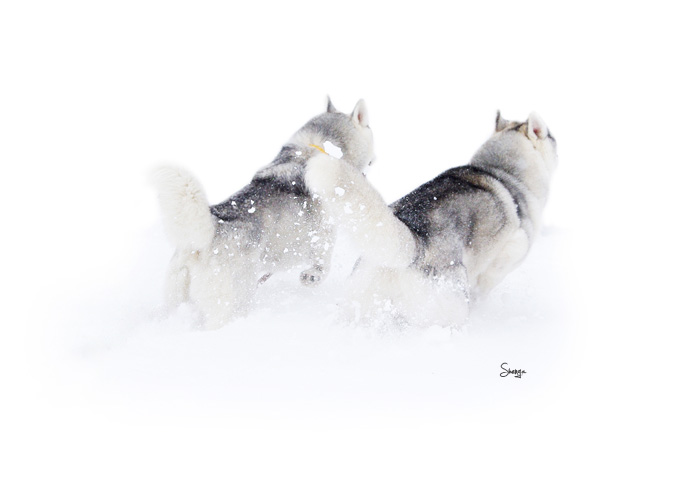The Siberian Husky
"The Siberian Husky is one of the most ancient and noble of all purebred dogs, but he is not the ideal pet for every family. His sled dog heritage provides him with an innate desire tor un, a very high energy level, and a degree of independence that is sometimes maddening. He typically does not come when he is called, he loves to dig holes, and he sheds his profuse coat once or twice a year by the bushel basketful. He is also an escape artist of Houdini - like abilities and absolutely requires a very secure fenced in yard or pen, preferably both. He also typically loves everyone, including any potencial buglar, thereby rendering him a "hopeless case" as a reliable guard dog."*
"On the other hand, the Siberian Husky is remarkably intelligente, clownish and charming. He loves children and is extremly sweet and gentle with them. He is extremly clean and odorless, making him an excellent choice as a companion for those with any tendency to dog - related allergies."*
"Although this multy-talented dog was assiginally bred principally as a sled dog, it currently performs many other roles in modern society. Besides beeing a wonderful family pet, he also serves as an active companion in a variety of outdoor sports and activities. Siberians are great jogging partners, willing tor un as far as you can."**
* Michale Jennings: The Siberian Husky, ** Kathleen Kanzler: A New Owner's Guide to the Siberian Husky
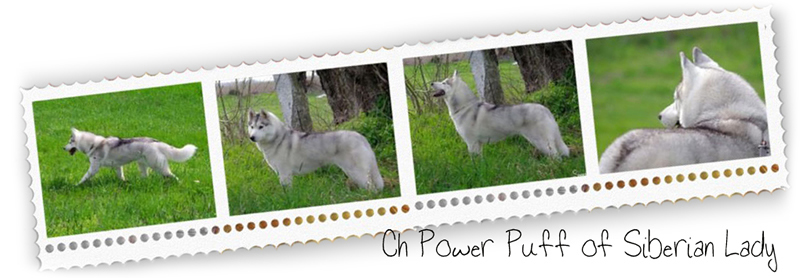
Standard
General Appearance
The Siberian Husky is a medium-sized working dog, quick and light on his feet and free and graceful in action. His moderately compact and well furred body, erect ears and brush tail suggest his Northern heritage. His characteristic gait is smooth and seemingly effortless. He performs his original function in harness most capably, carrying a light load at a moderate speed over great distances. His body proportions and form reflect this basic balance of power, speed and endurance. The males of the Siberian Husky breed are masculine but never coarse; the bitches are feminine but without weakness of structure. In proper condition, with muscle firm and well developed, the Siberian Husky does not carry excess weight.
Size, Proportion, Substance
Height--Dogs, 21 to 23½ inches at the withers. Bitches, 20 to 22 inches at the withers. Weight--Dogs, 45 to 60 pounds. Bitches, 35 to 50 pounds. Weight is in proportion to height. The measurements mentioned above represent the extreme height and weight limits with no preference given to either extreme. Any appearance of excessive bone or weight should be penalized. In profile, the length of the body from the point of the shoulder to the rear point of the croup is slightly longer than the height of the body from the ground to the top of the withers. Disqualification--Dogs over 23½ inches and bitches over 22 inches.
Head
Expression is keen, but friendly; interested and even mischievous. Eyes almond shaped, moderately spaced and set a trifle obliquely. Eyes may be brown or blue in color; one of each or parti-colored are acceptable. Faults--Eyes set too obliquely; set too close together. Ears of medium size, triangular in shape, close fitting and set high on the head. They are thick, well furred, slightly arched at the back, and strongly erect, with slightly rounded tips pointing straight up. Faults--Ears too large in proportion to the head; too wide set; not strongly erect. Skull of medium size and in proportion to the body; slightly rounded on top and tapering from the widest point to the eyes. Faults--Head clumsy or heavy; head too finely chiseled. Stop--The stop is well-defined and the bridge of the nose is straight from the stop to the tip. Fault--Insufficient stop. Muzzle of medium length; that is, the distance from the tip of the nose to the stop is equal to the distance from the stop to the occiput. The muzzle is of medium width, tapering gradually to the nose, with the tip neither pointed nor square. Faults Muzzle either too snipy or too coarse; muzzle too short or too long. Nose black in gray, tan or black dogs; liver in copper dogs; may be flesh-colored in pure white dogs. The pink-streaked "snow nose" is acceptable. Lips are well pigmented and close fitting. Teeth closing in a scissors bite. Fault--Any bite other than scissors.
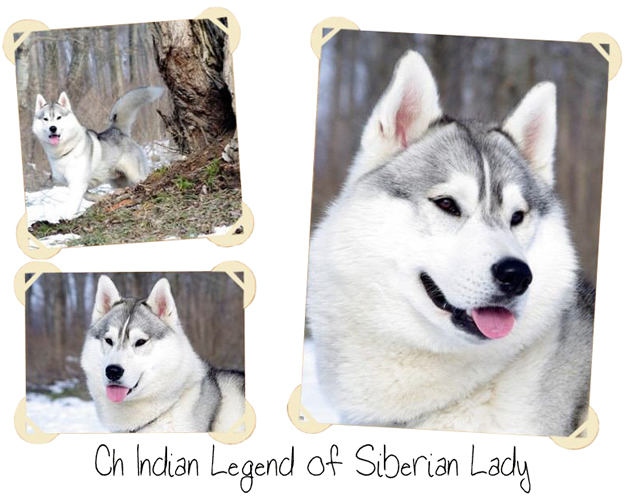
Neck, Topline, Body
Neck medium in length, arched and carried proudly erect when dog is standing. When moving at a trot, the neck is extended so that the head is carried slightly forward. Faults--Neck too short and thick; neck too long. Chest deep and strong, but not too broad, with the deepest point being just behind and level with the elbows. The ribs are well sprung from the spine but flattened on the sides to allow for freedom of action. Faults--Chest too broad; "barrel ribs"; ribs too flat or weak. Back--The back is straight and strong, with a level topline from withers to croup. It is of medium length, neither cobby nor slack from excessive length. The loin is taut and lean, narrower than the rib cage, and with a slight tuck-up. The croup slopes away from the spine at an angle, but never so steeply as to restrict the rearward thrust of the hind legs. Faults--Weak or slack back; roached back; sloping topline.
Tail
The well furred tail of fox-brush shape is set on just below the level of the topline, and is usually carried over the back in a graceful sickle curve when the dog is at attention. When carried up, the tail does not curl to either side of the body, nor does it snap flat against the back. A trailing tail is normal for the dog when in repose. Hair on the tail is of medium length and approximately the same length on top, sides and bottom, giving the appearance of a round brush. Faults--A snapped or tightly curled tail; highly plumed tail; tail set too low or too high.
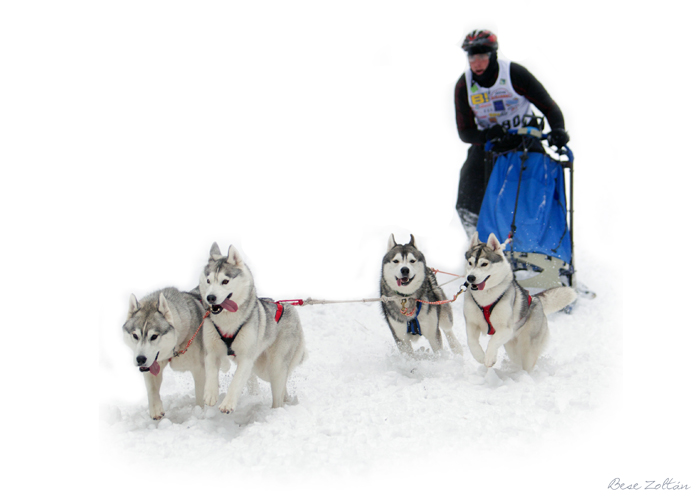
Forequarters
Shoulders--The shoulder blade is well laid back. The upper arm angles slightly backward from point of shoulder to elbow, and is never perpendicular to the ground. The muscles and ligaments holding the shoulder to the rib cage are firm and well developed. Faults--Straight shoulders; loose shoulders. Forelegs--When standing and viewed from the front, the legs are moderately spaced, parallel and straight, with the elbows close to the body and turned neither in nor out. Viewed from the side, pasterns are slightly slanted, with the pastern joint strong, but flexible. Bone is substantial but never heavy. Length of the leg from elbow to ground is slightly more than the distance from the elbow to the top of withers. Dewclaws on forelegs may be removed. Faults--Weak pasterns; too heavy bone; too narrow or too wide in the front; out at the elbows. Feet oval in shape but not long. The paws are medium in size, compact and well furred between the toes and pads. The pads are tough and thickly cushioned. The paws neither turn in nor out when the dog is in natural stance. Faults--Soft or splayed toes; paws too large and clumsy; paws too small and delicate; toeing in or out.
Hindquarters
When standing and viewed from the rear, the hind legs are moderately spaced and parallel. The upper thighs are well muscled and powerful, the stifles well bent, the hock joint well-defined and set low to the ground. Dewclaws, if any, are to be removed. Faults--Straight stifles, cow-hocks, too narrow or too wide in the rear.
Coat
The coat of the Siberian Husky is double and medium in length, giving a well furred appearance, but is never so long as to obscure the clean-cut outline of the dog. The undercoat is soft and dense and of sufficient length to support the outer coat. The guard hairs of the outer coat are straight and somewhat smooth lying, never harsh nor standing straight off from the body. It should be noted that the absence of the undercoat during the shedding season is normal. Trimming of whiskers and fur between the toes and around the feet to present a neater appearance is permissible. Trimming the fur on any other part of the dog is not to be condoned and should be severely penalized. Faults--Long, rough, or shaggy coat; texture too harsh or too silky; trimming of the coat, except as permitted above.
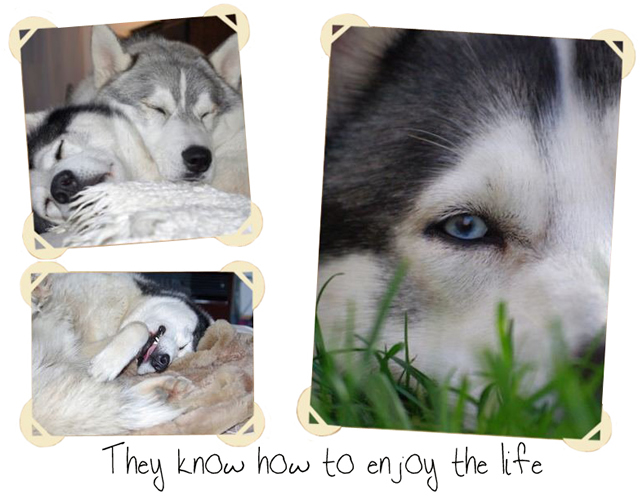
Color
All colors from black to pure white are allowed. A variety of markings on the head is common, including many striking patterns not found in other breeds.
Gait
The Siberian Husky's characteristic gait is smooth and seemingly effortless. He is quick and light on his feet, and when in the show ring should be gaited on a loose lead at a moderately fast trot, exhibiting good reach in the forequarters and good drive in the hindquarters. When viewed from the front to rear while moving at a walk the Siberian Husky does not single-track, but as the speed increases the legs gradually angle inward until the pads are falling on a line directly under the longitudinal center of the body. As the pad marks converge, the forelegs and hind legs are carried straightforward, with neither elbows nor stifles turned in or out. Each hind leg moves in the path of the foreleg on the same side. While the dog is gaiting, the topline remains firm and level. Faults--Short, prancing or choppy gait, lumbering or rolling gait; crossing or crabbing.
Temperament
The characteristic temperament of the Siberian Husky is friendly and gentle, but also alert and outgoing. He does not display the possessive qualities of the guard dog, nor is he overly suspicious of strangers or aggressive with other dogs. Some measure of reserve and dignity may be expected in the mature dog. His intelligence, tractability, and eager disposition make him an agreeable companion and willing worker.
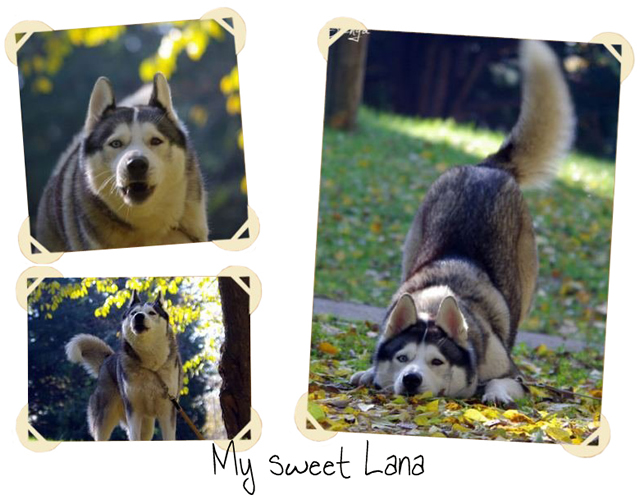
Summary
The most important breed characteristics of the Siberian Husky are medium size, moderate bone, well balanced proportions, ease and freedom of movement, proper coat, pleasing head and ears, correct tail, and good disposition. Any appearance of excessive bone or weight, constricted or clumsy gait, or long, rough coat should be penalized. The Siberian Husky never appears so heavy or coarse as to suggest a freighting animal; nor is he so light and fragile as to suggest a sprint-racing animal. In both sexes the Siberian Husky gives the appearance of being capable of great endurance. In addition to the faults already noted, the obvious structural faults common to all breeds are as undesirable in the Siberian Husky as in any other breed, even though they are not specifically mentioned herein.
Disqualification
Dogs over 23½ inches and bitches over 22 inches.
Approved October 9, 1990
Effective November 28, 1990
American Kennel Club
